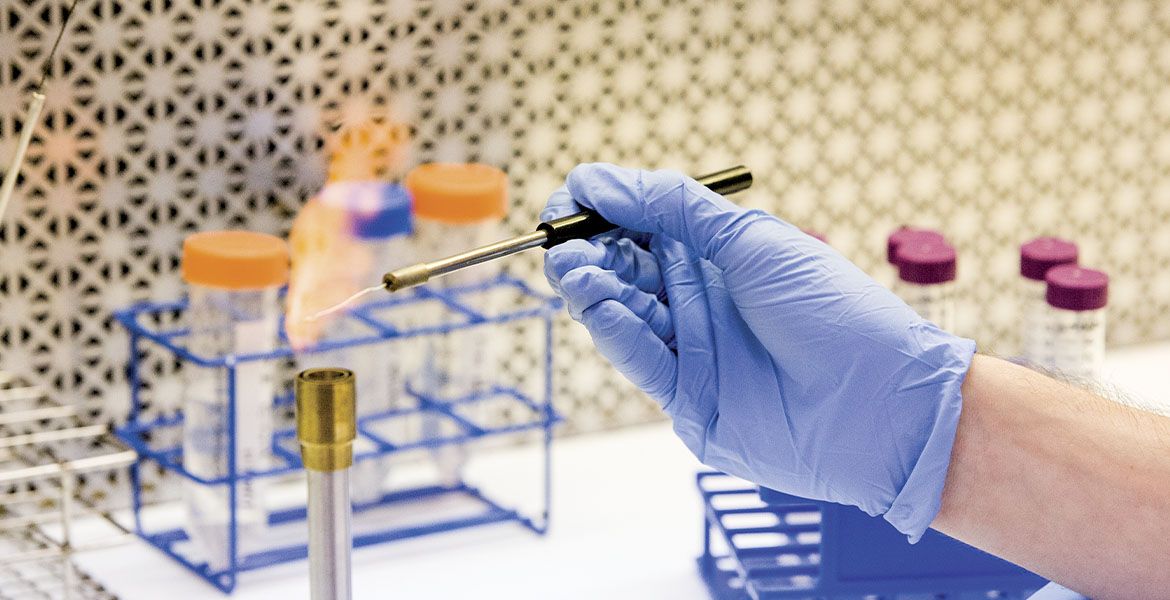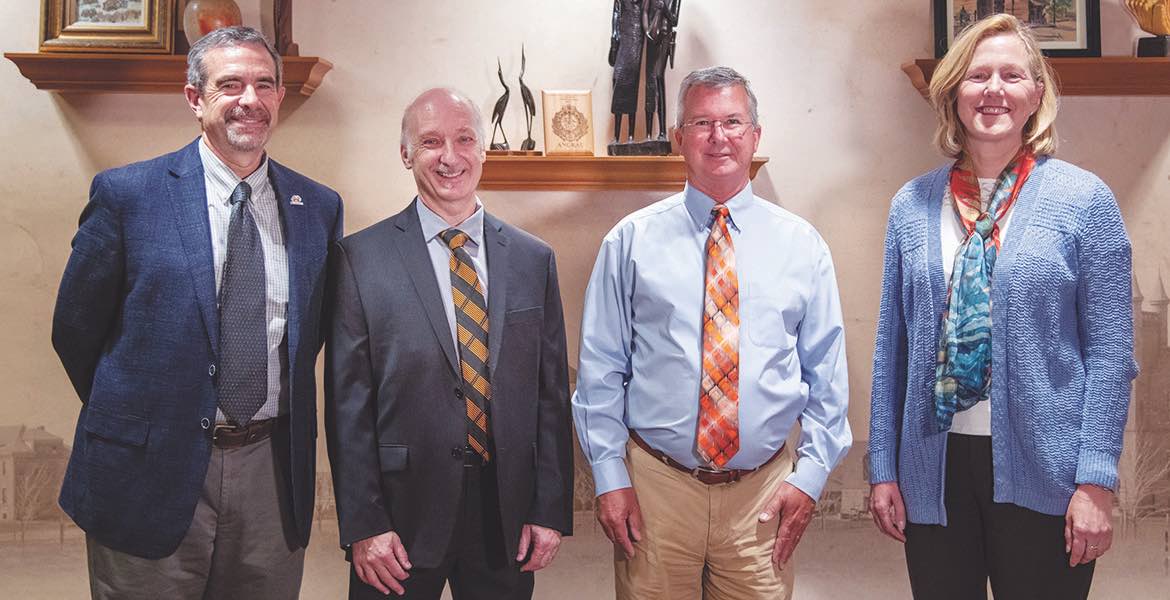
Oklahoma State's microbiome research could offer clues against COVID-19 and other diseases
Friday, August 28, 2020
With the outbreak of the COVID-19 pandemic, there might not have been a better time for Oklahoma State University to put together a Tier 1 Research Initiative on the microbiome.
Over the last 20 years, microbiome research has been gaining more attention in the scientific community. Over the next 10 years, OSU expects to become a national leader in the discipline, thanks to the Microbiome Initiative: Connecting the Microbiome to Health.
“Microbiome” refers to the community of bacteria, fungi, protozoa and viruses that inhabit a particular environment. They exist in places you might expect, such as your gut, and places you might not, such as clouds. The global microbi- ome includes millions of species, covering all Earth’s ani- mals, plants and physical environments. It can impact every aspect of the world’s ecosystem, including human, animal and plant health.
Microbiome science is complex because of the interactions of interconnected communities of organisms and their hosts or other microbial communities in food, water or the created environment. Though still in its infancy, microbiome science dominates thinking in the life sciences. For example, how much of a role, if any, do microbiomes play in the effect of COVID-19 on human bodies?
“Why do some individuals get sick and some don’t?” asked Jerry Malayer, one of the project’s four leaders and the College of Veterinary Medicine’s associate dean for research and graduate education. “Why do some respond to therapeutics and some don’t? It could also be some element of the microbiome is giving some people an advantage over others. That’s speculation and has to be tested, but I think that’s the direction that this may go.”
Gerwald Koehler, a microbiology professor at the Center for Health Sciences in Tulsa who is another project leader added, “Considering what we know so far about COVID-19 and the coronavirus, there might be a connection with the microbiome. The obvious connection we would look for is the lung microbiome, but there also seems to be a gut microbiome connection.”
OSU designated the Microbiome Initiative as a Tier 1 Research Initiative well before the pandemic began. The designation provides seed funding, laboratory equipment, new hires, student and staff support, and assistance in seeking external grants and partnerships.

The Microbiome Initiative aims to provide researchers across the university with tools to produce innovative, consistent and reproducible research that determines cause and effect. Those tools include access to experts about each area of the process, from securing samples to producing computer models that predict the effect of adjusting variables. Together, the expertise and appropriate facilities will create a pipeline to take an experiment from hypothesis to reliable results.
“OSU is positioned really well to become a leader in microbiome research,” said Tyrrell Conway, another of the project’s leaders and head of the Department of Microbiology and Molecular Genetics in OSU’s College of Arts and Sciences. “If you are a life science researcher of any kind, you are thinking about the microbiome. If you don’t have the capacity in your laboratory to test some of these things, you wish you did. That’s what the toolkit is for.”
The other project leader is Brenda Smith, a Regents Professor in the Department of Nutritional Sciences within the College of Education and Human Sciences and associate dean of the Graduate College.
“The biggest thing that this COVID- 19 situation does for me is to reinforce the all-important need for this research,” Smith said. “The microbiome is so integrated with our immune response. Anything we can do to enhance immunity is going to have implications on health and definitely infectious disease.”
The more researchers study microbiomes and consider their effects, the more it becomes apparent there is a lot to learn. That has led the initiative to create four subject groups, with an assigned leader for each:
• Bioinformatics — Pratul Agarwal, High Performance Computing Center
• Microbiology and Ecology — Mostafa Elshahed,
Department of Microbiology and Molecular Genetics
• Gut-Brain Axis — Gerwald Koehler, OSU-CHS Department of Biochemistry and Microbiology
• Nutrition — Janeen Johnson, Department of Animal and Food Science.
“Nobody is an expert in all of these things, so the formation of these groups is really important,” Conway said. “They will meet about monthly and share ideas and information, and then bring the best of that conversation to the larger meetings of the entire Microbiome Initiative.”
With them so far are about 70 collaborators across OSU.
"OSU is positioned really well to become a leader in microbiome research."
“This is a great opportunity to have collaborative research,” Koehler said. “It’s going to lead to more interdisciplinary research. My vision is toward engaging more clinicians and social scientists in microbiome research.”
Conway is excited about microbiology receiving increased attention from the public
lately. Early in his career,
he would tell people he was a biologist because most didn’t understand what a microbiologist was. Now most people know the term, and many have at least some idea
about the concept of microbiomes. For example, they know antibiotics can lead to complications
such as digestive issues or yeast infections.
“The interest in microbiomes is a movement,” Conway said. “Microbiologists have known for many decades that microbes live in communities. But now lots of people who aren’t microbiologists are doing things like taking prebiotics to feed bacteria, stimulating growth. They are taking probiotics to introduce microbes that are beneficial. They are beginning to get that we are a cloud of our microbiomes.”
Over the past decade, Koehler has increasingly focused his research on microbiomes, especially the gut-brain axis. For example, is there a connection between the composition of someone’s microbiome and whether they have severe depression or anxiety?
“We see changes that correlate in humans and experimental models,” Koehler said. “We see changes that correlate with some depressive- like behavior in animals and deep depression in humans. The question is, how do we get from correlations to mechanisms? We need to find out if depression causes changes in the microbiome, or do changes in the microbiome cause depression?”
He is also excited about research into how the microbiome relates to neurodegenerative diseases such as Parkinson’s and gastroenterological issues such as inflammatory bowel disease. It may even play a part in causing cancer.
“Microbiome science is a great opportunity to learn things that we didn’t even know that we didn’t know,” Koehler said. “There are so many areas where people haven’t even considered the trillions of microorganisms within us. When you get a physical now, they check your blood. In a couple of years, we might also get our microbiome checked to see if there is anything wrong with that.”
While Koehler studies the gut-brain axis, Smith’s expertise is the gut-bone axis. She notes that bones are greatly affected by a body’s immune response, and the current understanding is that about 70 percent of a body’s immune cells reside within the gut. “You are what you eat” makes a lot of sense as it relates to the microbiome.
"Microbiome science is a great opportunity to learn things that we didn’t even know that we didn’t know."
“What we consume affects the microbiome, which in turn influences the immune cells residing within the wall of the intestine. These cells can then migrate to the bone or other tissues to either promote an inflammatory response or suppress the immune response,” Smith said. “What we’ve learned in even the last decade is going to change the way we do nutrition.”
Today, nutritional recommendations are typically based on an individual’s age, gender and if a woman is pregnant or lactating. With an increased understanding of the microbiome, a much more individualized approach to nutrition recommendations may soon be the norm.
“This is a paradigm shift,” Smith said. “It’s changing the way we think in nutrition.”
For example, there are some compounds that aren’t traditional nutrients, such as resveratrol in red wine and EGCG in green tea, that are known to have robust health benefits. Yet studies have shown they are poorly absorbed by the body.
“If we consider the microbiome, maybe the target of their action isn’t that I drink green tea and the EGCG ends up in some tissue,” Smith said. “Maybe the action is primarily taking place in the gut, where it is metabolized by microbes that alter the immune cell response.”
Malayer’s expertise is cellular communication and interaction. For him, the idea of the global microbiome is “almost perfect.”
“We talk about One Health — the concept that the health of animals, humans, plants and the environment are linked,” Malayer says. “In research, the things we find in one environment can apply to another. At a basic level, processes of tissues, cells and organs are similar across species.”
The goal of microbiome science is to understand which microbes are present, what they are doing and how they are interacting. That leads to research questions about the effects of eliminating certain classes of organisms, allowing other classes to expand.
“We’re talking about millions of bacteria, millions of genes they are expressing, and millions of metabolites,” Malayer said. “That’s a very complex system. With artificial intelligence machine learning and supercomputers, we think we can program a computer to model that at some scale. That will let us do predictive analysis. ‘What would happen if you eliminate an organism? What would happen if you introduced a probiotic or prebiotic?’”
OSU has tremendous resources for multidisciplinary microbiome research.
Through the Microbiome Initiative, Malayer says OSU is empowering researchers to “plug into a pipeline” of expertise and specialized equipment that will allow them to “build your model without having to reinvent the wheel.” They will train students, “who will become the next generation of scientists, and they will be doing a lot more of this kind of work.”
He added, “There is potential to discover new processes and organisms in these various environments with commercial potential. The sky is the limit if we get everything in place. There are institutions that do things like this now, but I don’t think anywhere has the breadth of potential application that OSU does.”
